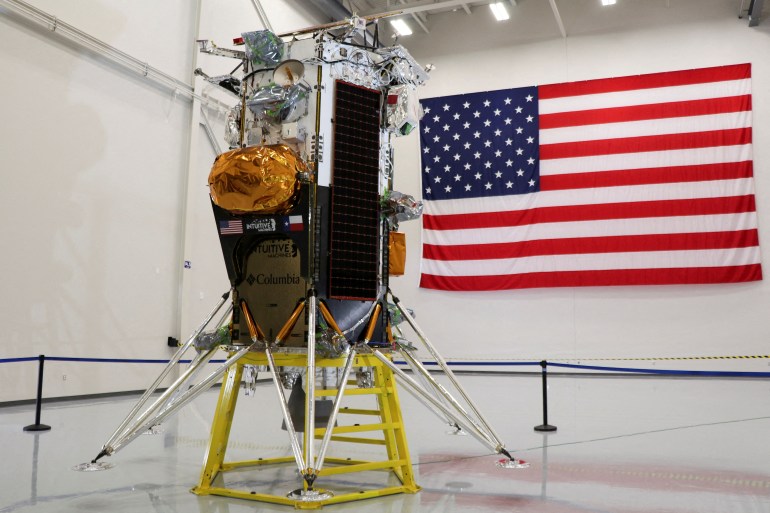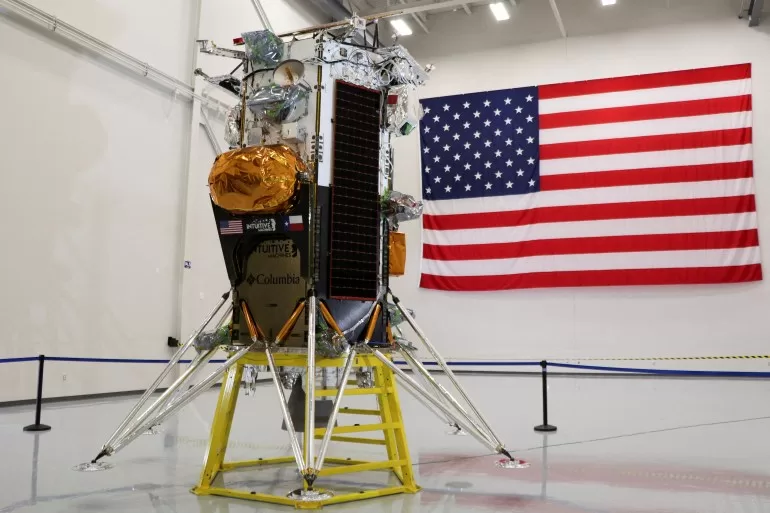The moment marks the first successful landing of a commercial spacecraft on the moon, following an unsuccessful US lunar lander mission last month.
Here is what we know about the moon landing and Odysseus:
What’s the Odysseus moon lander?
Odysseus is the first craft launched from the US to land on the moon’s surface since the Apollo 17 in 1972.
Odysseus, also known as “Odie”, is a type of lunar lander designed by Intuitive Machines, a commercial lunar missions group which has the goal of delivering small “payloads” to the surface of the moon.
For this mission, during which the environment at one of the moon’s poles will be investigated, NASA paid Intuitive Machines $118m under a programme known as Commercial Lunar Payload Services (CLPS).
According to EVONA, a space industry recruiter, “a payload is the part of a spacecraft that is responsible for achieving the mission’s primary objectives … [they] can be scientific instruments, communication equipment, or any other specialised equipment that is needed for the mission”.
This model of lunar lander is called a Nova-C. Intuitive Machines reportedly described it as roughly the size of a British telephone booth with legs attached. According to NASA, it’s a hexagonal cylinder with dimensions of 4.0 metres tall and 1.57 metres wide.
The lander is equipped with five NASA payloads and one commercial one – a total of 100kg.
NASA’s cargo comprises exploration and other equipment. “The NASA payloads will focus on demonstrating communication, navigation and precision landing technologies, and gathering scientific data about rocket plume and lunar surface interactions, as well as space weather and lunar surface interactions affecting radio astronomy,” the space agency said in a statement.

According to Joel Kearns, the deputy associate administrator for exploration in NASA’s Science Mission Directorate, this is similar to a cargo mission.
“NASA pays a company to take our equipment, our science, to the moon all the way down to the surface and get our data back,” Kearns told Al Jazeera.
“But this is the company’s mission, they go off and make their lander, they buy a rocket, they design their mission, they get all their communications set up, we are just a paying cargo customer, just as if we were shipping a parcel to somebody’s house,” he added.
Art and technology are also on board. Among the items is a box from American artist Jeff Koons which contains 125 small stainless steel balls to represent the moon’s different phases through a month. The artwork is associated with individuals who have made important accomplishments in history.
“In this way, Koons honours some of the greatest achievements of the past to inspire future generations,” Intuitive Machines said.
We’ve landed! Congratulations to Intuitive Machines & SpaceX for their astounding achievement of realizing this historic private mission to the Moon! I’m so honored to have my Moon Phases artworks be part of the Odysseus mission! @Int_Machines @SpaceX @NASA #jeffkoons #moonphase pic.twitter.com/yQq80zgdck
— Jeff Koons (@JeffKoons) February 23, 2024
At what time was the moon landing?
Odysseus landed at 6:23pm EST (23:23GMT) on Thursday.
It was launched by SpaceX from NASA’s Kennedy Space Center in Florida, on February 15, using a Falcon 9 rocket launcher.
Falcon 9 propelled the lander into Earth’s orbit, reaching speeds of more than 40,000km per hour. Once the rocket depleted its fuel 48 minutes about 223km (139 miles) above the Earth, it separated from Odie, leaving the lunar lander to navigate independently through space. The lander used an on board stellar map to establish its orientation in space, aligning its solar panels with the sun’s rays to recharge its batteries.
If its mission doesn’t face any setbacks, the hexagonal solar-powered lander will spend seven days operating on the moon, working until the sun sets each lunar day. When the lunar night sets in, the lander will enter sleep mode.
Your order was delivered… to the Moon! 📦@Int_Machines‘ uncrewed lunar lander landed at 6:23pm ET (2323 UTC), bringing NASA science to the Moon’s surface. These instruments will prepare us for future human exploration of the Moon under #Artemis. pic.twitter.com/sS0poiWxrU
— NASA (@NASA) February 22, 2024
How did the moon landing unfold?
After a journey of roughly 400,000km (250,000 miles), the lander began a 73-minute descent down to the surface of the moon on Thursday. Intuitive Machines CEO Stephen Altemus said at the start of the mission that the spacecraft had about an 80 percent chance of success.
During the mission, controllers faced a potentially mission-halting technical issue.
In the few hours before the landing, the craft’s laser navigation system failed, according to The Associated Press. The Intuitive Machines’ flight control team had to rely on an experimental NASA laser system that was on board instead – the Navigation Doppler Lidar. The lander had to make an extra lap around the moon to allow time for the last-minute switch.
“We put the Navigation Doppler Lidar … as a tech demo and as a test, we weren’t planning to use it for the actual mission … but now we are. So, basically, it is the primary system to help provide the velocity and altitude information,” NASA’s Space Tech mission directorate deputy associate administrator Prasun Desai said.
“We put the [Navigation Doppler Lidar for Precise Velocity and Range Sensing] as a tech demo and as a test, we weren’t planning to use it… for the actual mission… but now we are. So, basically, it is the primary system to help provide the velocity and altitude information.” —… pic.twitter.com/yLl4YuhBTC
— NASA Technology (@NASA_Technology) February 22, 2024
Following the successful landing by Odysseus, however, initially there was no signal from the moon lander.
As the minutes passed, there were initial concerns about the lander’s status but eventually a communications link between the lander and the control team on Earth was established. Within a couple of hours, Intuitive Machines had reported that “Odysseus [was] upright and starting to send data”, and was able to show images.
“We can confirm without a doubt our equipment is on the surface of the Moon and we are transmitting,” said flight director Tim Crain after controllers detected a weak signal from Odysseus’ high gain antenna. We are awaiting an update on the condition of the spacecraft. pic.twitter.com/mFoPpM8k7a
— Spaceflight Now (@SpaceflightNow) February 23, 2024
What is Odie expected to achieve?
As well as delivering its payloads, the lunar lander is designed to evaluate the environment at the moon’s south pole as NASA prepares to send a crewed mission in September 2026 with Artemis III.
The moon’s southern polar region is believed to contain abundant water ice. Prior to deploying astronauts to this area, however, the agency wants to gather additional data. This information will help evaluate factors such as the quantity of water present and the accessibility of this vital resource.
NASA’s aim is to establish a permanent lunar base for human voyagers and, eventually, a launching point for Mars.
“The goal here is for us to investigate the moon in preparation for Artemis, and really to do business differently for NASA,” Sue Lederer, Commercial Lunar Payload Services project scientist at Johnson Space Center in Houston, said during a press conference.
“One of our main goals is to make sure that we develop a lunar economy,” she added, referring to NASA’s ambition to build a market in which privately owned companies compete to be part of the journey.
“There is so much more that we have to learn about the moon,” Ali Bramson, a planetary scientist from Purdue University told Al Jazeera. “Everything from how it formed, to the technologies needed, to how people survive on the surface of the moon, so much science and technology that we still have to learn at the moon,” she added.
Who else is sending missions to the moon?
A modern moon rush is taking place worldwide. Over the past year, India and Japan have both landed probes on the moon.
China has had rovers there for more than a decade, but Odysseus is the first privately built craft to make the journey.
After the Odysseus lander, the next spacecraft set to head to the moon may be Chang’e-6 from China, a robotic lunar mission which aims to augment the country’s collection of lunar rocks and soil. The China National Space Administration has announced that the launch is scheduled for May 2024.
What were the reactions to the landing?
NASA administrator Bill Nelson said: “Today for the first time in more than a half-century, the US has returned to the moon.
“Today is a day that shows the power and promise of NASA’s commercial partnerships.
“What a triumph, Odysseus has taken the Moon”.
Today, for the first time in half a century, America has returned to the Moon 🇺🇸.
On the eighth day of a quarter-million-mile voyage, @Int_Machines aced the landing of a lifetime.
What a feat for IM, @SpaceX & @NASA.
What a triumph for humanity.
Odysseus has taken the Moon. pic.twitter.com/JwtCQmMS2K
— Bill Nelson (@SenBillNelson) February 23, 2024
After the confirmation of success – and many stressful hours – the broader team, including families and mechanics, also joined in the celebrations.
The initial signal is weak but @Int_Machines has confirmed that Odysseus Nova-C lander is on the Moon! #IM1 Congratulations!!! pic.twitter.com/Q3wgl1Z5mt
— Jason Major (@JPMajor) February 22, 2024
